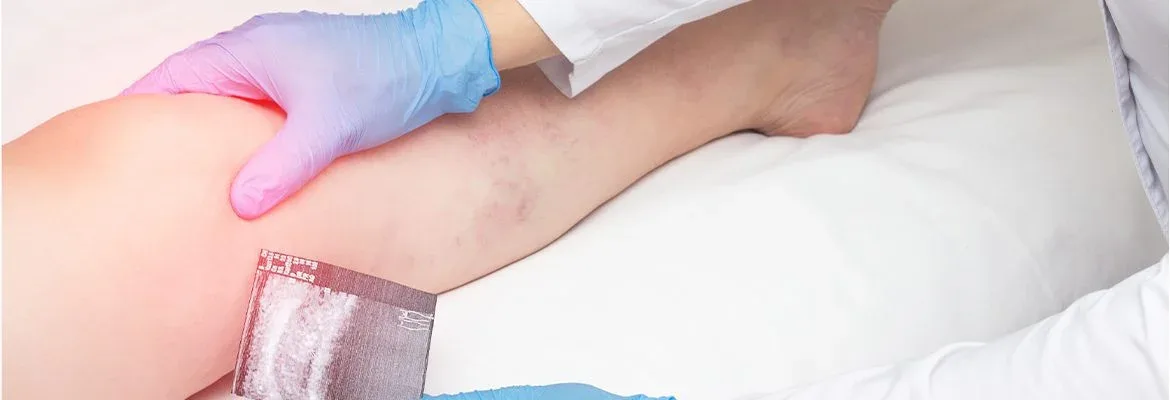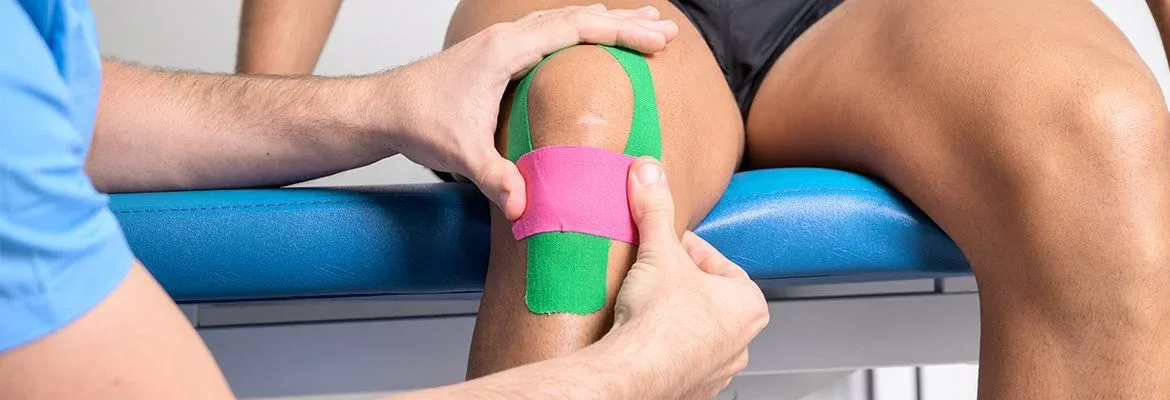Medial knee pain describes discomfort or pain experienced inside the knee joint. Several disorders, including osteochondritis dissecans, meniscus tears, arthritis, MCL injuries, and patellofemoral pain syndrome, can bring it on. It is crucial to receive accurate diagnosis and treatment from a specialist.
Aside from Swelling, stiffness, clicking or popping noises, and limited mobility in the knee joint, medial knee discomfort can fluctuate in intensity. Walking, running, climbing, and descending stairs can worsen the pain. Physical examination, medical history review, and imaging tests like X-rays, MRIs, or ultrasounds are frequently used to diagnose medial knee discomfort. Depending upon what caused the pain in the first place, treatment options could include rest, ice, compression, elevation, painkillers, physical therapy, braces, or other supports, and in extreme situations, surgery.
Ignoring medial knee pain might result in more damage or problems, ultimately reducing your capacity to carry out everyday tasks. Therefore, if you have recurrent medial knee pain, getting medical help is crucial.
I. Causes of Medial Knee Pain

Medial knee pain can be a frustrating and debilitating condition that affects many individuals. There are a variety of causes of medial knee pain, ranging from overuse injuries to degenerative diseases. The path to successful medical care and managing such pain lies in identifying and addressing its root causes.
· Medial Collateral Ligament Tears – MCL
A tissue structure on the inside of the knee called collateral ligaments, the medial collateral ligament (MCL) aids in stabilizing your knee when you move it. You may injure this tissue when you fall onto your knee or collide with another athlete while playing a sport. It may also be brought on by weak or overused muscles that alter how your knee moves and place more strain on the inner side of the knee joint. The MCL may get torn or progressively weakened as a result of this.
MCL injuries frequently present as severe inner knee discomfort that worsens with leg flexion or extension. Your doctor may reach this conclusion after analyzing your medical files and completing a physical examination. They will examine your injured knee by applying pressure to the affected area and moving your knee in various directions. They could perform an MRI scan to assess the severity of your MCL injury.
The following are typical signs of an MCL tear:
Medial Knee Pain: Medial knee pain might occur when climbing stairs or engaging in sports.
Swelling, bruising sharp pain, and pain around the affected ligament
Knee Instability: The knee may feel unstable, especially when twisting is involved.
Knee Stiffness: Potentially restricted knee movement
Arthritis and muscular imbalance are two more conditions that can cause severe inner knee pain. Due to the degenerative nature of osteoarthritis, your knee cartilage may deteriorate, and your bones may begin to rub together, resulting in aching pain and excruciating agony. An inflammatory condition called rheumatoid arthritis can also hurt your knees in the center.
Pes anserine bursitis, which develops when a little sac of fluid around the inside of your knee, called a “bursa” becomes irritated and filled with fluid, is another frequent issue that can cause inner knee pain. Walking up or down stairs, bending or straightening your leg, or doing any of these things can make your knee pain and swell up. You might also hear a clicking or crackling sound when you move your jumper’s knee part.
· Medial Meniscus Tear
A knee joint injury that affects the medial compartment of the cartilage is known as a medial meniscus tear. The medial meniscus injury is a segment of cartilage with a C shape that serves as a shock absorber and aids in distributing body weight throughout the knee joint. The cartilage inside the knee joint is harmed when the medial meniscus is torn.
Sudden twisting or rotating knee motions, as during sports or other physical activity, can result in medial meniscus tears. They may also develop through wear and tear over time, especially in older people. A medial meniscus tear can cause knee discomfort, pain on the inside of the knee, Swelling, stiffness, popping or clicking noises, and a restricted range of motion. The knee might feel unstable or give way occasionally.
Examining the body, reviewing the patient’s medical history, and imaging tests like an MRI are frequently used to diagnose a medial meniscus tear. Depending on the extent of the incision, several treatment options are available, such as rest, ice, compression, elevation, painkillers, physical therapy, and, in extreme situations, surgery to either repair or remove the damaged cartilage.
· Pes Anserine Bursitis
The pes anserine bursa is in the lower leg’s medial knee (inside). To shield the tendons from compression and friction brought on by movement, it rests between the bone underneath and the tendons. When the bursa is inflamed, the area is exceedingly sensitive and painful. The most common symptoms are inside-knee pain, especially when running or ascending stairs. Sitting down or crossing your legs might also worsen the knee pain treatments since they put more pressure on the bursa.
Rest and minimizing bursa compression are the main goals of treatment for pes anserine bursitis. It is typically accomplished by avoiding activities that aggravate the area, using ice on it, and using non-steroidal anti-inflammatory drugs. Physical therapy is frequently advised to strengthen the muscles around the hip and knee and lessen stress on the bursa. Surgery can be required if conservative approaches don’t reduce pain.
Among the injuries we treat at Robotic Hip and Knee Replacement LA includes pes anserine bursitis. For a discussion with one of our specialists to review your treatment options, contact us if you are experiencing the pain and Swelling associated with this condition. You can swiftly get back on your toes with our help, and we have a cutting-edge facility! Call right away to make an appointment!
· Knee Arthritis
People of every age are prone to the painful, degenerative condition known as knee arthritis. It is characterized by joint stiffness and Swelling, which frequently causes the knee to creak, pop, or grind (crepitus). Some people with knee arthritis find it challenging to perform daily tasks like cleaning, cooking, chasing after children, and going up or down stairs.
Strengthening the leg’s ability to flex (bend) and extend and providing stability from side to side are a healthy knee’s strong muscles and ligaments. In the knee joint, the extremities of the tibia and femur (shinbones) meet and are cushioned by articular cartilage. This tough yet smooth substance keeps the shin bones from directly touching and facilitates smooth knee movement. Menisci, two wedge-shaped bits of cartilage that serve as “shock absorbers” to support the knee, are located between the tibia and the femur. A membrane surrounding the knee releases fluid to lubricate the joint and lessen friction between the bones and cartilage.
Despite being the largest and most powerful joint, the knee is prone to damage. As time passes, the hard and smooth cartilage that prevents bones from applying pressure against each other may deteriorate, leading to discomfort, Swelling, and stiffness. Knee arthritis can appear due to aging, overuse, or injury. The likelihood of developing knee arthritis is higher in people who are overweight or have had prior knee injuries.
Given that it depends on the extent of the symptoms, multiple treatments may be effective for treating knee arthritis. The initial step is to discuss the issue with a doctor. They will do a physical examination and request diagnostic procedures like X-rays. The stage of the disease and other criteria, such as how much the pain and stiffness interfere with everyday activities, will determine the sort of treatment a person receives for knee arthritis.
Lifestyle changes are beneficial for knee arthritis, particularly if they are implemented early. Physical activity and weight loss can help by relieving pressure on the knee joint. Patients can learn strengthening exercises from therapists to help with daily tasks and knee strength. Surgery can be required if pain and movement issues continue despite nonsurgical therapy.
· Medial Plica Syndrome
Patients with big, thick plicas and repetitive knee flexion/extension (bending/straightening) injuries may experience pain and click due to the medial synovial fold rubbing on the margins of the patella. The quadriceps mechanism’s weakening or the degenerative alterations in the knee joint may make this rubbing worse with activity. Because of the medial patella’s oblique orientation regarding the femoral condyle, genu valgus, and knock knees frequently worsen the issue.
On inspection of the afflicted knee, the plica is typically not felt since the surrounding area is swollen. Although a plica can be detected with an MRI scan, the plica is rarely the only source of a problem. X-rays are rarely helpful because they cannot reveal the plica’s thickness, but they could aid in ruling out other issues, such as meniscal tears and articular cartilage injury.
II. Diagnosing the Source of Inner Knee Pain

medial knee pain
The common cause of the pain will determine the diagnosis. For example, physiotherapy and other nonsurgical treatments may use to address arthritis or ligament injury. Depending on how serious the issue is, surgery can be suggested.
The ends of your tibia (shinbone) and femur (thigh bone) are cushioned by cartilage, which helps to reduce friction when you move your knee. Accidents and constant wear and tear are two ways cartilage can be harmed. It could result in acute inner knee discomfort that worsens as you bend or straightens your leg. Additionally, it could feel stiff and swollen. Additionally, you can have clicking or the sensation that your knee will lock.
Your knee contains a variety of cartilage types. The meniscus is the articular cartilage that covers the bottoms of your thigh and shin bones together. You could damage your meniscus if you twist your knee or descend stairs. This kind of knee injury frequently results in rapid-onset pain more severe than other kinds of sports injuries or knee discomfort.
The source of your knee pain will be diagnosed after an in-depth examination by a medical professional. They might recommend imaging procedures like an MRI, X-ray, or ultrasound to look at the interior of your knee. To determine whether you have an autoimmune disease like rheumatoid arthritis, they could also need blood testing. In those who have this ailment, certain antibodies will be searched for.
Your doctor will advise measures to speed up your recovery if they believe your knee discomfort results from an injury. These may include giving leg muscles around your knee some rest, applying ice, and taking medicines like ibuprofen or naproxen. A knee brace or a tubular bandage around your knee may also be prescribed.
Although they’re inappropriate for everyone, knee supports can help you manage your knee pain. Using a graft from another area of your body or a donor, your doctor may advise surgery to repair a torn ligament or cartilage.
Even with knee discomfort, it’s crucial to stay active. Exercise regularly can assist in easing pain and stop it from returning. But remember to warm up, stretch, and cool down before and after your workout. Strength exercise is also beneficial for strengthening the muscles in your knees, particularly the quadriceps and hamstrings.
Your mood may be impacted by knee discomfort, which can become crippling if it persists for an extended period. It’s important to share your feelings with someone; a friend or family member, a counselor, or a general practitioner. If you require counseling, the NHS is happy to help. Joining a support group for those with a chronic illness or disability may also be beneficial. It will enable you to give advice and ideas to people experiencing similar issues. It may also be an effective approach to making new friends. Information about regional groups is available on the NHS website.
III. Knee Joint Pain: The Common Culprits and Risk Factors
For numerous causes, medial knee pain is typical. One of the main causes is that regular everyday activities like walking, running, and climbing stairs put a lot of internal pressure on the knee joint, which is a weight-bearing area. Soccer, basketball, and skiing are just a few sports and physical activities that use the medial knee joint and may add to the medial knee injuries joint’s stress.
The structures on the inside side of the knee joint are more vulnerable to injury than other areas, which is another factor contributing to the prevalence of medial knee pain. It is so because the medial collateral ligament (MCL), a band of tissue that joins the thigh bone to the shin bone on the inside of the knee, supports the medial knee joint. A football tackle or a skiing accident is two examples of activities that frequently result in MCL ligament injuries because they entail rapid changes in direction or contact with the knee joint.
The inside side of the knee joint also houses the medial meniscus, a C-shaped piece of cartilage that serves as a stress absorber in the knee joint. The medial meniscus is prone to aging-related wear and tear and acute injury, which can result in a rip and cause medial knee discomfort.
The middle side of the knee joint is a popular location for pain and discomfort due to weight-bearing stress, injury susceptibility, and participation in sports and physical activities.
IV. Treatment of Medial Knee Pain

medial knee pain
“medial knee pain” describes the discomfort felt within the knee joint. Numerous things, such as an overuse injury, trauma, or underlying medical issues, might lead to it. According to the source of the pain and the intensity of the signs and symptoms, the treatment for medial knee pain can vary.
· Ice and rest
Placing the knee joint to rest and icing the area is one way to reduce swelling and relieve pain. Several times every day, 20 minutes of ice needs to be used.
· Physical Exercise
Physical therapy may be recommended to improve flexibility of knee tendon and help the muscles around the knee cap and joint get stronger. This may aid in reducing pain and averting harm in the future.
· Medications
The painkiller and aspirin are two over-the-counter medications that can help alleviate pain and inflammation. Painkillers on prescription may be needed in specific situations.
· Knee Supports
A knee brace can provide support for the joint or affected leg that has been injured and reduce pain. Knee braces may assist in initial injury and limiting additional harm.
· Injections
Injections of corticosteroids may be recommended to help with discomfort and decrease inflammation. Usually, an inflamed knee joint is the focus of these injections.
· Surgery
Sometimes, the operation may be necessary to fix damage to the knee joint or the connective tissue around it. This could involve procedures like arthroscopic or a total knee replacement.
V. Recommended Exercises for Medial Knee Pain

· Straight Leg Raises
This exercise targets the quadriceps muscles, which are important for knee stability. Place one straight leg above the other knee and lie on your rear end. Lift the straight leg to the height of the bent knee and hold for a few seconds before slowly lowering it back down. Repeat for several reps before switching legs.
· Hamstring Curls
Hamstring curls help to strengthen the muscles located at the back of the thigh, which can help to support the knee. Lie on a bench or exercise ball with your legs hanging off the edge. Bend your knees gradually so that your heels are touching your buttocks. For a few seconds, maintain this position before releasing. Repeat for several reps.
· Wall Squats
Wall squats can help to strengthen the quadriceps and gluteal muscles, which can help to support the knee joint. Stand with your back against a wall and your feet shoulder-width apart. Slowly lower yourself into a squat position, keeping your back against the wall. Hold for a few seconds before slowly standing back up.
· Step-Ups
Step-ups can help to strengthen the quadriceps, gluteal and calf muscles, which can help to support the knee joint. Stand in front of a step or bench with one foot on top. Step up onto the court, lifting your other foot as well. Step back down and repeat for several reps before switching legs.
· Leg Press
The leg press machine can help to strengthen the quadriceps, gluteal and calf muscles, which can help to support the knee joint. Sit on the device with your feet on the platform and your knees bent. Push the platform away from you, straightening your legs. Slowly bend your knees and lower the platform back down. Repeat for several reps.
VI. Frequently Asked Questions
- What causes medial knee pain with flexion?
- Various factors, including meniscus tears, ligament sprains, or knee osteoarthritis, can cause medial knee pain with flexion. It can also be caused by improper form during exercise or physical activity.
- What are the common causes of anterior medial knee pain?
- Common causes of anterior medial knee pain include ligament sprains, patellar tendonitis, or chondromalacia patella. It can also be caused by improper form during exercise, sports injury or physical activity.
- How can one prevent or treat medial knee pain while running?
- To prevent or treat medial knee pain while running, it is important to have proper form and footwear, gradually increase the intensity and duration of workouts, and incorporate strength training exercises to improve muscular support around the knee. Rest, ice, compression, and elevation (RICE) can also reduce pain and inflammation. Consultation with a healthcare professional may also be necessary for proper diagnosis and treatment.
